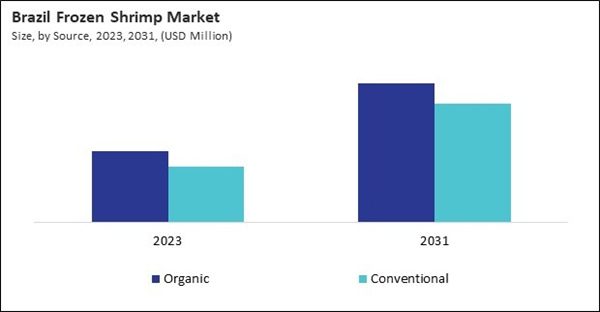In the frozen shrimp market, the business-to-business (B2B) distribution channel plays a crucial role in connecting producers, processors, distributors, and food service providers. B2B transactions in this sector involve bulk purchases of frozen shrimp for commercial and industrial purposes, catering to restaurants, hotels, catering companies, and institutional buyers. Thus, B2B channels in Brazil registered a volume of 26.24 hundred tonnes in 2023.
The Brazil market dominated the LAMEA Frozen Shrimp Market by Country in 2023, and would continue to be a dominant market till 2031; thereby, achieving a market value of $368.8 million by 2031. The Argentina market is showcasing a CAGR of 11.4% during (2024 - 2031). Additionally, The UAE market would register a CAGR of 10.1% during (2024 - 2031).
Direct-to-consumer sales allow shrimp producers to build direct relationships with their customers, engaging with them through email newsletters, social media, and other digital channels. E-commerce platforms and direct-to-consumer sales allow shrimp producers to quickly adapt to changing consumer preferences and market trends, offering new products and promotions to meet demand. Online sales channels provide valuable consumer feedback through product reviews and ratings, allowing producers to improve their products and services continuously.
Furthermore, rising disposable incomes enable consumers to allocate more of their budget to food purchases, including premium and value-added products such as this shrimp. With higher disposable incomes, consumers are more likely to afford premium seafood products like this shrimp, often priced higher than other protein sources.
Saudi consumers are increasingly seeking convenient food options due to their busy lifestyles. The expansion of organized retail chains has increased the availability of this shrimp in Saudi Arabia. Supermarkets and hypermarkets offer a wide range of frozen seafood options, including different varieties of shrimp, catering to consumer demand in Saudi Arabia. Convenience and specialty food stores are also stocking shrimp to cater to the growing demand for seafood among urban consumers in Saudi Arabia. Ready-to-cook and ready-to-eat shrimp products are gaining popularity among Saudi consumers who seek convenient meal solutions that require minimal preparation. Thus, due to these aspects, the market will expand across the LAMEA region in upcoming years.
Based on Source, the market is segmented into Organic and Conventional. Based on Application, the market is segmented into Food, Cosmetics, Pharmaceuticals, Biotechnology and Industrial. Based on Distribution Channel, the market is segmented into Supermarkets & Hypermarkets, B2B, Departmental Stores and Online Sales Channel. Based on countries, the market is segmented into Brazil, Argentina, UAE, Saudi Arabia, South Africa, Nigeria, and Rest of LAMEA.
List of Key Companies Profiled
- Surapon Foods Public Company Limited
- Thai Union Group PCL
- Clearwater Seafoods Corporation (Premium Brands Holdings Corporation)
- Aqua Star
- SeaPak Shrimp & Seafood Company
- Lerøy Seafood Group ASA
- Avanti Feeds Limited
- The Waterbase Limited
- Mazzetta Company, LLC
Market Report Segmentation
By Source (Volume, Hundred Tonnes, USD Billion, 2020-31)- Organic
- Conventional
- Food
- Cosmetics
- Pharmaceuticals
- Biotechnology
- Industrial
- Supermarkets & Hypermarkets
- B2B
- Departmental Stores
- Online Sales Channel
- Brazil
- Argentina
- UAE
- Saudi Arabia
- South Africa
- Nigeria
- Rest of LAMEA
Table of Contents
Companies Mentioned
- Surapon Foods Public Company Limited
- Thai Union Group PCL
- Clearwater Seafoods Corporation (Premium Brands Holdings Corporation)
- Aqua Star
- SeaPak Shrimp & Seafood Company
- Lerøy Seafood Group ASA
- Avanti Feeds Limited
- The Waterbase Limited
- Mazzetta Company, LLC
Methodology

LOADING...









